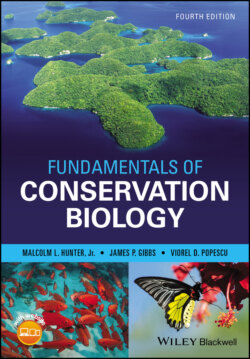Читать книгу Fundamentals of Conservation Biology - Malcolm L. Hunter Jr. - Страница 88
Ecosystems and Landscapes
ОглавлениеThe mosaic of ecosystems we see from a plane is not just a random array. There are patterns to the spatial configurations of ecosystems. Lakes are drained by rivers and bordered by marshes, woodlots are patches embedded in a matrix of agricultural ecosystems, clearcuts are patches in a matrix of forests, and so on. Human‐dominated landscapes in particular have a regularity of pattern and a sharp‐edged character not found elsewhere. Ecologists call these mosaics of ecosystems landscapes, and a subdiscipline called landscape ecology has developed (Forman 1995 ; Turner and Gardiner 2015) (Fig. 4.11). For example, landscape ecologists are interested in ecosystems that occur as long, narrow strips such as rivers and their associated riparian (shore) ecosystems because these ecosystems may serve as corridors that facilitate organisms moving among ecosystems. Also of interest to landscape ecologists are the edges between ecosystems. The interface between a forest and a field is one example: it will be avoided by some species and preferred by other species (Hunter and Schmiegelow 2011).
Figure 4.11 Ecologists refer to a mosaic of interacting ecosystems as a landscape. How many different types of ecosystem can you recognize in this fine‐scale landscape on the coast of Maine, USA?
(Drew Tarvin/Flickr/CC BY 2.0)
Conservation biologists are interested in landscape phenomena for a number of reasons that we will examine further in subsequent chapters. Two brief examples will suffice here. First, many endangered species are large animals that have large home ranges – tigers, wolves, elephants, etc. – that encompass many ecosystems. If we wish to maintain habitat for these species, we must maintain entire landscapes that provide for all their needs. Second, human activities have left many natural ecosystems as islands, isolated in a “sea” of human‐altered ecosystems, and conservation biologists are concerned with what happens along the edges of these small, residual patches. Are they being degraded by factors that originate externally such as exotic species, pesticides, and changes in local climate?
These and similar issues have led conservation biologists to advocate maintaining biodiversity from a landscape perspective (Groves and Game 2016). This is a way of saying that it is not sufficient to protect a representative array of ecosystems. We must also ensure that these ecosystems are arranged spatially so as to maintain the natural relationships among them. In short, to conserve biological diversity we should maintain natural, functioning landscapes composed of many interacting ecosystems.
